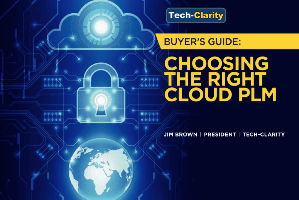 What do manufacturers need to know when they select a cloud Product Lifecycle Management (PLM) solution?
What do manufacturers need to know when they select a cloud Product Lifecycle Management (PLM) solution?
Although manufacturers have started to adopt cloud solutions for many aspects of their business, PLM has lagged behind. Our research shows that over one-half of manufacturers are considering cloud and about one-quarter already leverage the cloud support product innovation and manufacturing. Given the increased interest and adoption, we developed selection criteria to help companies navigate the options and choose the best-suited PLM cloud option for their business.
Please enjoy the summary* below. For the full research, please visit our sponsor PTC (registration required).
Table of Contents
- Cloud PLM Adoption Increasing
- PLM Benefits and Business Value
- Increased Value/ROI of Cloud PLM
- Buyer’s Considerations
- Choosing the Right PLM
- Considerations for Product Developers
- Considerations for IT
- Considerations for Adoption
- Review Deployment Options
- Evaluate Pricing Options
- Choose the Right Partner
- Special Considerations
- Conclusions and Recommendations
- Acknowledgments
Cloud PLM Adoption Increasing
 A Solution First Approach
A Solution First Approach
Cloud solutions are becoming more popular, yet PLM adoption in the cloud has been slower than other applications. The transition, however, is picking up pace. In fact, more companies are now asking, “why not the cloud?” instead of “why consider cloud?”. We commend that companies pick their solution first and then choose their deployment option. This is effectively a “solution first” approach as opposed to a “cloud first” approach. We find that companies are just not willing to shortchange functionality in this crucial area. They recognize it’s important to evaluate the functional capabilities of a PLM system to ensure they’ll gain the significant top- and bottom-line benefits that PLM delivers.
PLM Benefits and Business Value
Product Lifecycle Management (PLM) spans multiple levels, offering value in multiple ways. PLM basics help manage products, parts, collaboration and release processes which leads to important benefits including increased productivity, preventing errors, reduced cost, improved quality, enhanced reliability, and more.
 Enterprise PLM expands that value by further helping companies develop, manufacture, and support their products. Our PLM Beyond Managing CAD study finds that expanded PLM use improves business performance, and that higher performing companies have more departments and third parties using PLM.
Enterprise PLM expands that value by further helping companies develop, manufacture, and support their products. Our PLM Beyond Managing CAD study finds that expanded PLM use improves business performance, and that higher performing companies have more departments and third parties using PLM.
Get the Right PLM to Provide the Value
PLM drives tangible business value. This value is evolving and expanding quickly as companies pursue digital enterprise initiatives and expand the benefits to new business models capabilities. This value is available, but requires the right PLM system.
Conclusions and Recommendations
The Cloud Offers Compelling Benefits
The cloud makes the significant business value of PLM more accessible and reduces TCO for manufacturers. It offers new opportunities to enhance global reach and collaboration. But there are important things to consider when selecting a cloud PLM system, ranging from deployment options to considerations for certain industries and geographies.

Recommendations for Cloud PLM Selection
To help companies research and analyze potential solutions based on company needs, including needs that help deliver benefits well into the future, Tech-Clarity offers the following recommendations:
- Evaluate functional solution capabilities first, unless company standards mandate a deployment approach.
- After selecting the right functional solution, evaluate and select optimal deployment and pricing models that give your business the most benefit considering cost, risk, and time to achieve value.
- Consider the strategic value of cloud solutions for global deployments to support “design anywhere, build anywhere” strategies.
- Make sure to consider the future, including the transition to the digital enterprise. We believe that manufacturers that don’t digitalize will be at a competitive disadvantage.
- Narrow down solutions based on these high level criteria to create a smaller list of solutions to evaluate.
- Recognize that any solution selection process will require tradeoffs and understand which types of requirements are the most important to your company’s success and profitability
*This summary is an abbreviated version of the research and does not contain the full content. For the full research, please visit our sponsor PTC (registration required).
If you have difficulty obtaining a copy of the research, please contact us.

